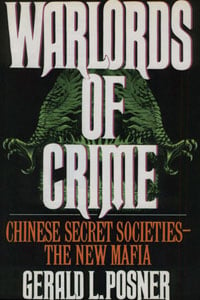Great Britain’s decision to transfer control of Hong Kong to Communist China by 1997 has spurred a flight from the colony. Despite reassurances from Beijing, money is flowing out of Hong Kong at an accelerating rate. Among those who are moving their assets are the Chinese crime syndicates—the Triads.
While they are expanding their criminal empires in Western Europe and Canada, the Triads’ destination of preference is the United States. Their presence is growing and has prompted California Attorney General John Van de Kamp to warn that, “There hasn’t been a mass exodus of criminals on this scale since 1980, when Fidel Castro opened up his prisons and flushed the worst elements of Cuban society—the Marielitos—into Florida.” He fears that the stage is being set for a “catastrophe, unless we send word across the Pacific that this is a dangerous and inhospitable place for gangs to do business.” That Van de Kamp’s remarks are not exaggerated is supported by the findings of New York City-based investigator Gerald Posner, author of the first book-length account of the Chinese Triads. In Warlords of Crime, Posner traces the history of the Triads and reveals how their influence is spreading across the country.
The Triads date back to the 17th century, when patriotic Han Chinese founded secret societies to fight the foreign Manchu invaders and restore the Ming dynasty. By the end of the 19th century, many Triads had largely abandoned their political idealism and had transformed themselves into highly organized criminal enterprises. Leading politicians, including Dr. Sun Yatsen, found it expedient to trade favors with the powerful Triads, who gained greater opportunities for profits after the Manchu were finally overthrown in 1911.
Triads have been active in Hong Kong since 1842. During World War II, they tended to cooperate with the Japanese, to control the dockyards, and were able to penetrate the labor markets. Additional Triads fled to Hong Kong, Macao (the nearby Portugese colony that comes under Beijing authority in 1999), and Taiwan, after Mao seized power on the mainland in 1949.
Posner reports that today. Hong Kong is the headquarters for at least fifty secret Triads, who have a combined membership of some 300,000 people. One society, the 14 K Triad, has nearly 30,000 members. Posner notes that many Triad members are of Chiu Chau descent, from the Swatow region of southern China. They play a role in Asian crime similar to that of the Sicilians in the Italian Mafia.
Triads are involved in gambling, prostitution, extortion, loansharking, protection rackets, murder-for-hire, and political corruption. However, their most important source of wealth derives from their control of the world’s major supplies of heroin. Posner escorts his readers on a tour of the “Golden Triangle,” the hilly area bordering Burma, Laos, and Thailand, where over 70 percent of the world’s opium is grown. As the author points out, this virtual monopoly “gives them an advantage that other criminal syndicates do not have. . . . Without heroin they are just another group of criminals. With heroin they have a potential for profit unmatched in the annals of organized crime.”
Posner explains how the opium is refined into heroin and discloses the methods used to smuggle tons of that substance around the globe. Hong Kong and Rotterdam currently are the keys in their distribution network, since these two ports have the heaviest volume of traffic, making it nearly impossible—especially in the present political and economic environment—to monitor cargoes passing through them. Heroin is repackaged and shipped out of Hong Kong and Rotterdam to the drug markets in Europe and North America.
“Crack” and the Cocaine Cowboys have captured the headlines in America in recent months, a development that has tended to obscure the impact of the problems created by our heroin addicts. Yet, as Posner reminds us, there are an estimated 750,000 heroin addicts in the US, up from 500,000 addicts when President Nixon declared his own “war on drugs” back in 1971. These heroin users are responsible for nearly three-quarters of urban crime. Despite millions of dollars spent on anti-heroin efforts, only AIDS has had any real effect in retarding the growth in the number of junkies.
As the author admits, it was the changes in US immigration laws made in 1965 that opened the door to Chinese criminals: since that year, Chinese and other Asian immigrants have flooded into our country. The FBI reports that Asian youth gangs are employed as “street muscle” by the Triads, who in the US operate through Tongs (the word, which is derived from “Town Hall,” describes fronts that often publicly engage in charitable work in Chinese communities). These Asian syndicates pose special problems for law enforcement, since their members are bound to secrecy, and the almost insurmountable barriers of language, dialect, and culture make prosecution difficult in the extreme.
In short, as Posner’s remarkable book makes evident, the US currently has almost no capability to deal with the Triads. And as we approach 1997, this failure of law enforcement becomes even more critical. Posner is to be commended for preparing his chilling expose. But will the United States meet this new challenge? Given how we have reacted to the Cuban, Colombian, Mexican, Haitian, Jamaican, Nigerian, Vietnamese, and other criminal gangs that have come into the country in recent years, I, for one, am not betting that we will.
[Warlords of Crime: Chinese Secret Societies—The New Mafia, by Gerald L. Posner (New York: McGraw-Hill) 289 pp., $18.95]

Leave a Reply